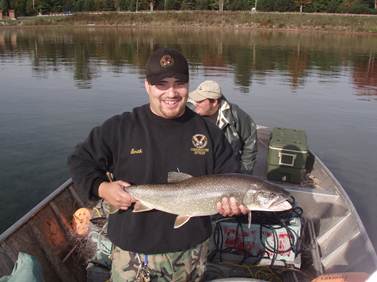Lake Trout Assessments
Spring, summer and fall lake trout surveys are conducted throughout Keweenaw Bay and western Lake Superior following protocols established by GLIFWC and the Lake Superior Technical Committee. These survey efforts are shared and compared with agencies and datasets across the Lake Superior Basin as a means of gauging lake trout abundance and health on a broad spatial scale, and are critical in providing fisheries data from the Keweenaw Bay region. Fish are measured, weighed, assessed for sea lamprey attacks, disease, overall condition/ health, tags and fin clips (indicating hatchery fish), etc.
Portions of the survey catch are tagged and released to monitor post-survey survival and migration patterns. Dead fish are at times analyzed even more intensively, with stomach extractions, age structure collections (i.e. scales and/or otoliths for estimating fish age), genetics sampling, and possibly other data being collected from each and every fish captured. Some of the KBNRD data sets collected are decades old, and have allowed researchers to analyze trend data and prescribe best management recommendations for fisheries management.
Keep an eye out for tagged fish!
Photo: KBIC Law Enforcement Officer Everett Ekdahl with a wild lean lake trout
captured during a spring survey. This fish was tagged and released after important
length, weight, and condition information was collected.

Many KBIC fisheries survey efforts include the tagging and release of important species, including lake trout, lake whitefish, lake sturgeon, and walleye, to name a few. We encourage those who utilize the fisheries resources of Lake Superior to be on the lookout for fish with KBIC and/or other Agency fish tags. Each tag has unique identification colors, codes and Agency labels. Typically, tags are located along the back of the fish, but in some instances tags can be found on the jaw or very near the eye. On rare occasion tags can be found along the stomach or near the tail. In any case, tag information submissions can assist fisheries managers in tracking movements and survival of fish they have previously handled. Tag and/ or information submissions preferably include date and location of fish capture, condition of fish and whether the fish was kept or released. Monetary rewards are often associated with credible information submissions associated with tags.

"If you do encounter a fish tag, mail the tag (if keeping the fish for consumption), or write down and mail/ call in tag information for possible reward (see contact info below).
KBIC Natural Resources Department (Fisheries Division)
14359 Pequaming Road
L’Anse MI 49946
Phone: (906) 524-8200
Thanks and Good Luck Fishing!
